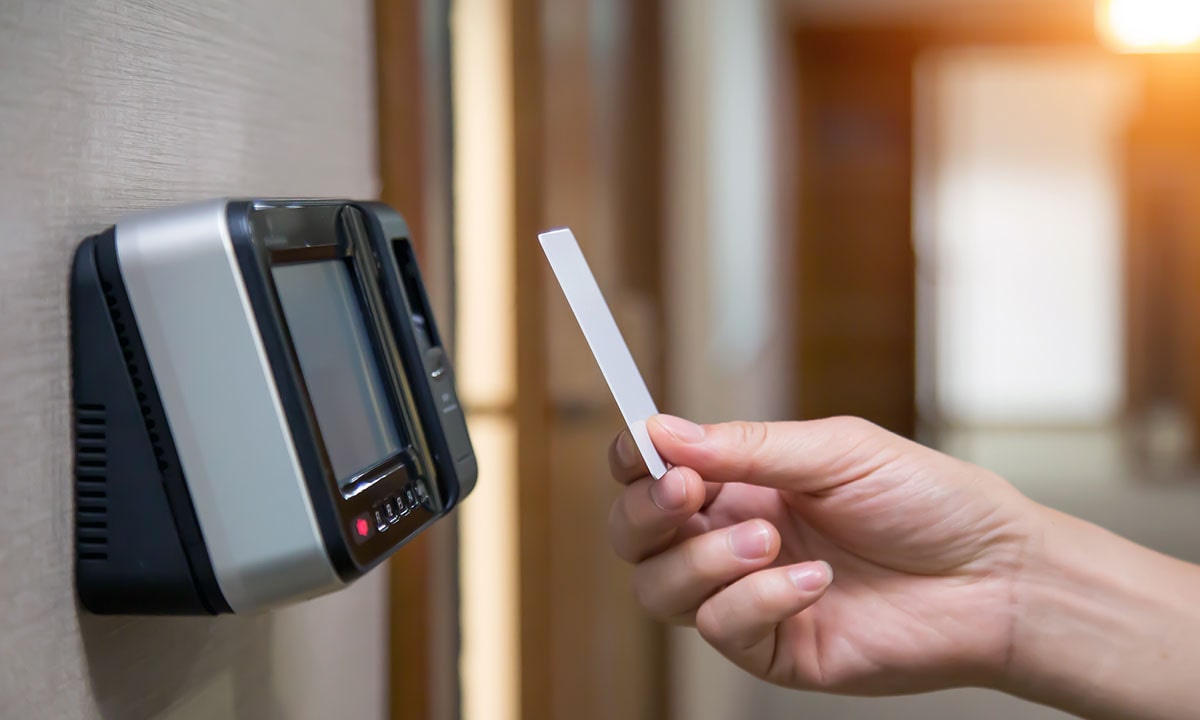Modern security is constantly evolving with new ways to protect your customer’s assets. Almost everything is going digital, and that includes door locks. Modern electronic door locks are becoming extremely popular in today’s interconnected world.
Let’s take a look at the perks and drawbacks of both mechanical and electronic door locks. Each is ideal for specific uses that we’ll outline below. This guide will help you decide which lock type best fits the needs of the job.
Mechanical Door Locks
When thinking of a door lock, most commonly, it’s a mechanical lock that springs to mind. These conventional door locks have been around for thousands of years and will continue to be an option for simple security. Unlike electronic door locks, these do not require any electrical energy to operate.
Types of Mechanical Door Locks
- Mortise lock: This is a typical type of door lock. It provides decent security, but it’s difficult to install as it requires drilling a pocket into the door.
- Cylinder lock: Another common type of mechanical door lock, offering different cylinder formats that indicate varying levels of security. However, these locks can be quite fragile, and are vulnerable to breaking when pressure is applied.
- Spring bolt: Spring bolts are mechanical door locks that are spring-loaded bolts with an angled edge.
- Deadbolt: A deadbolt is a lock bolt that is moved by turning a knob or key without a spring. This lock requires a key to open, and is more resistant to forced entry than a spring bolt.
Pros
- Reliably used for thousands of years
- Longer lifespan
- Does not require electricity
- Weatherproof
- Easy to operate
- Doesn’t require batteries to change or recharge
Cons
- Not as advanced as electronic door locks
- Does not log when the door has been opened and closed
- Keys are easily lost or stolen
- Might require multiple lock changes
- It can often take longer to gain entry when fumbling with keys
Electronic Door Locks
Electronic door locks eliminate the need for a key and add automation features, such as remote locking and unlocking. These electronic door locks can be controlled and monitored through a smartphone.
Types of Electronic Door Locks
- Coded entry: This is the most common type of electronic door locks. A keypad is placed outside the door, and a code must be entered to unlock it.
- Smartphone-operated lock: As the name suggests, these locks require a smartphone to be activated, and they can be operated from anywhere. These locks normally require an app, and through them, a customer can preset lock and unlock times. Some even include monitoring features that notify your customer if someone tries to break into their home or office.
- Biometric: Biometric door locks are operated through a fingerprint, so all you have to do is place a finger on the lock to gain entry. Other biometric options include voice-activation and eye scanners, however, these electronic door locks can be expensive.
- Key fob/key card/proximity card: Key fob, key card and proximity card locks are electronic locks that require a customer to touch the fob/card to a surface near the lock. This is similar to using Apple Pay or Google Pay in stores with a smartphone.
The Rise of Smart Door Locks
- Ring: Ring sells a variety of commercial and residential security systems, but they’re most commonly known for their doorbell cameras. These new web-enabled security cameras give a customer the opportunity to answer the door whether they’re home or away. These electronic door locks simply detect motion on a doorstep, send a smartphone notification, and allow you to see, hear and speak with the visitors. Ring works within the Alexa ecosystem of web-connected products. This suite of products can operate seamlessly with numerous web-enabled and Bluetooth smart locks.
- Nest: Now owned by Google, Nest is also an increasingly popular home security system, teaming with Yale to create a web-connected keypad lock. Nest mounted cameras track motion to activate recording. This smart-home system allows a customer to monitor what’s going on inside or outside of their home at all times. Facial recognition is available with all Nest cameras to alert a customer to familiar faces and strangers.
Pros
- Additional security
- Easy to add or change combinations
- Easy to access in the dark
- Automatic preset lock times
- Ability to monitor access
- Logs when the door has opened
Cons
- Need electrical source (e.g. hardwired, battery, solar, etc.)
- May need regular battery changes
- Power outage may inhibit entry if there’s no backup power supply
- Expensive
Important Features to Consider
Security
Both mechanical and electronic door locks are capable of securing a location. However, it’s best to look for graded locks based on specific security needs. Grade 1 is best, Grade 2 is standard, and Grade 3 is the least secure. Grade 1 is mainly used for commercial settings, while Grade 2 is for light-commercial applications, and Grade 3 is residential grade, perfect for a typical family.
Keyless Convenience
This is a no-brainer since electronic door locks don’t require a key to operate. Electronic door locks are especially great for businesses, as a customer can set multiple combinations for different people or groups. Plus, you can easily update viable combinations the minute staffing changes.
Access Control
Electronic door locks are more easily accessible because all you have to do is program a unique access code instead of fumbling around with different keys. Also, keypad electronic locks can give a general overview of who’s been in and out of the building. Consider issuing employee-specific proximity cards when requiring specific granular metrics on who is entering and exiting a building.
Affordability
Both mechanical and electronic door locks have a wide range of price points, but mechanical locks tend to be less expensive. Most electronic locks can range anywhere from $200 on the lower end to $2,500 on the higher end.
On the other hand, mechanical door locks range in price from as affordable as $50 to $1,500. Also, some brands include different features that can suit different needs, therefore, the prices may vary.
Style and Design
Mechanical door locks generally offer a more comprehensive range of styles and finishes, while electronic locks favor more minimal, sleek designs. For those looking for a more modern look throughout their home or business, electronic door locks might be the best option.
Smart Home Compatibility
If automation is important, along with convenience and extra security, electronic door locks are the answer. Please note: be sure to pay attention and make sure that they’re compatible with existing devices in the building.
Safe and Secure
Deciding between mechanical and electronic door locks will likely come down to the specific application. A customer may find that a mechanical lock’s versatility and electricity-free functionality fits the situation best.
In other instances, an electronic door lock would be ideal. In the end, it’s best for the customer to be informed on all the available options before completing their project, and securing a location.



